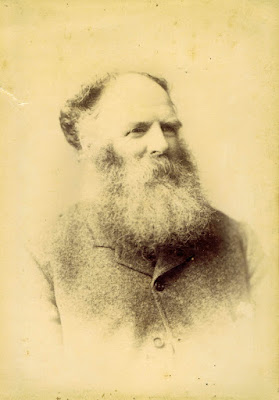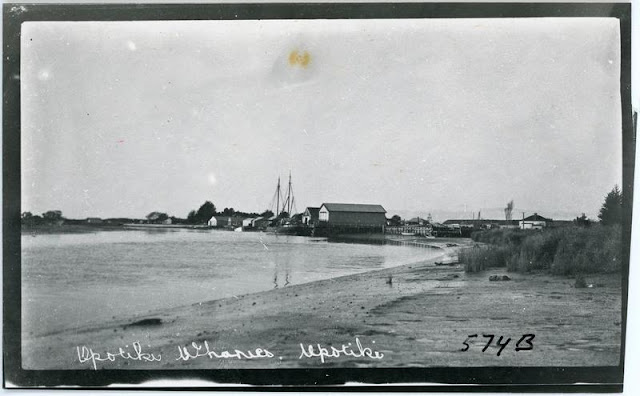Located off Matata, the low lying Rurima Islands or Rurima Rocks, were brought to the attention of Tauranga’s residents by the Bay of Plenty Times on 12 May 1921. At 4.25 a.m. on the 11th, the Northern Steamship Company steamer Tasman struck a reef near the south-western rock while steaming to Whakatane. The passengers and crew were saved, but the ship was lost along with all cargo and mail. The passengers and crew came ashore without their luggage and personal effects at Matata and Pikowai in three lifeboats, before being transported in trucks to Tauranga.[1]
 |
| The Northern Steamship Company vessel SS Tasman |
Built in Auckland in 1903, the 179-ton kauri and iron steamer was 102 feet in length and powered by 280hp compound engines.[2] Placed on the Auckland to Whakatane run by the company, the SS Tasman was a regular sight at Tauranga’s Victoria Wharf between 1909 and 1921. There, it offloaded and took on new passengers, freight and mail, as well as coal for its boilers.
A Nautical Inquiry into the wreck of the SS Tasman held at the Auckland Magistrates Court the following month, expressed focused on four issues:
- The chief officer Mr. McManus was on watch and in charge of the Tasman with Captain William John Grigg also on the bridge when the vessel struck.
- Though the weather was squally, it was possible to see the higher points of the Rurima Group and also Whale Island. The vessel struck an island which could be seen at the time the accident occurred.
- When the steamer struck on the south-west point of the Rurima Group, there was about three miles of shore room between the shore and where the incident occurred.
- The course was a perfectly well-known one and had been run in perfect safety for the last 50 to 60 years and the Tasman was jammed for time to catch the bar at Whakatane.
 |
| The Rurima Islands The SS Tasman struck a reef on the south-west corner of the Rurimu group |
In evidence, Captain Grigg stated that he had been master of that steamer about three or four months before May 11. He had also been master of the Tasman at different periods and had originally been chief mate of the Tasman for close on three years. During that time the steamer had been wholly engaged in the Auckland to Whakatane trade. He had also been master of other vessels in the Northern Company’s fleet.
On the night of the disaster, he had kept a course close inside Mayor Island, which was passed at about 10 o'clock. He had followed his usual course, which he had always found a safe one, inside Whale Island. When passing Motiti Island the weather was clear, with no sea and just a medium breeze.
He was below when the mate called him at ten minutes to four, and told him they were close to Matata light, which was then just for'ard of the starboard beam. At this time, they were about two miles off Matata. As several other “objects” were in view, and Grigg "took a shot" at them over the steering compass, but took no other steps to place them accurately.
While the weather then was ‘fairly clear’ overhead, they were surrounded by black clouds. The wind was fresh, with squalls at times, from the S.S.W. Shortly after, the mate observed that the land was a little closer and altered the course half a point to the southward. A few minutes later the Tasman struck. The time was then within a few minutes of 4.25. He thought the vessel struck at the south-west corner of the Rurima Group.
According to the mate, the vessel did not seem to rest on the reef for any appreciable time, and backed her off, he steered straight for the mainland. SS Tasman sank scarcely a mile off Rurima.
Captain Grigg stated that he could have gone outside Whale Island that night, but there was smoother water on the inside. Mr. McManus, he said, had been his chief mate all the time he was on the run, and he had found him perfectly reliable as a navigator.[3]
 |
| A coastal steamer at Victoria wharf 1810s |
On 9 June, the Nautical Court of Inquiry found that the SS Tasman was off her proper course when it struck one of the Rurima rocks and was wrecked. The first officer was adjudged negligent in not ascertaining his correct distance off' the land at Town Point (Maketu). The court also found that Captain Grigg, the ship’s master:
[D]id not exercise good judgment when deciding what distance the vessel was off the land at Matata. The court was further of the opinion that when the chief officer drew the master’s attention to the ship’s closeness to the Rurima rocks, the master, in sending a message to the officer on the bridge to alter the course a quarter of a point to the south, was not taking sufficient precautions for the safety of the vessel.[4]
Despite being found guilty of negligence and fined 20 and 10 pounds respectively towards the costs of the inquiry, Grigg and McManus did not lose their certificates.[3] Evidence had been put before the court that, in the vicinity of White Island, the needle of the compass would be liable to be deflected by the magnetic disturbance which existed at the time the grounding occurred.[5]
Sinking just 30 minutes after its initial grounding, the remains of the SS Tasman - the boiler, part of the hull and the engines - lie in 27 meters of water between the Rurimas and Matata.
End Notes
[1] Bay of Plenty Times, 12 May 1821: 3.
[2] Rurima Island, Wikipedia, https://en.wikipedia.org › wiki › Rurima Island
[3] Auckland Star, 6 June 1921: 7.
[4] New Zealand Times, 10 June 1921: 5.
[5] Ibid: 10 June 1921: 5.
Illustrations
[1] H. Winkelmann, SS Tasman 1903-1921, Auckland Weekly News, 19 May 1921, Auckland Council Libraries - Kura AWNS-19210519-43-01
[2] Photographer unknown, Rurima Islands, Wai 46 # A3, Te Rangahau Whenua Raupatu O Ngati Awa Report to Department of Conservation, 25 July 1992: 15.
[3] Frederick Radcliffe, Postcard, Tauranga, Victoria Wharf, 1910s. Accession number 0846/08. Tauranga Heritage Collection








%202.jpg)




.jpeg)